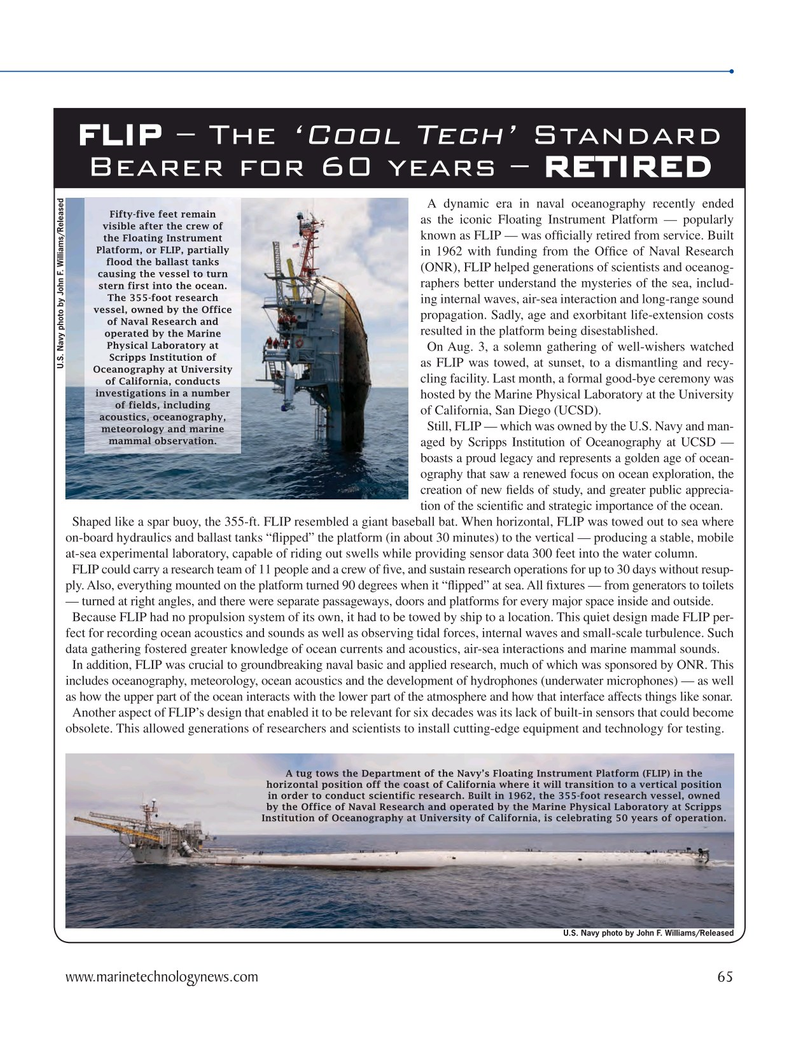
Page 65: of Marine Technology Magazine (September 2023)
Read this page in Pdf, Flash or Html5 edition of September 2023 Marine Technology Magazine
FLIP – The Standard ‘Cool Tech’
Bearer for 60 years – RETIRED
A dynamic era in naval oceanography recently ended
Fifty-five feet remain as the iconic Floating Instrument Platform — popularly visible after the crew of known as FLIP — was of? cially retired from service. Built the Floating Instrument
Platform, or FLIP, partially in 1962 with funding from the Of? ce of Naval Research flood the ballast tanks (ONR), FLIP helped generations of scientists and oceanog- causing the vessel to turn raphers better understand the mysteries of the sea, includ- stern first into the ocean.
The 355-foot research ing internal waves, air-sea interaction and long-range sound vessel, owned by the Office propagation. Sadly, age and exorbitant life-extension costs of Naval Research and resulted in the platform being disestablished.
operated by the Marine
Physical Laboratory at
On Aug. 3, a solemn gathering of well-wishers watched
Scripps Institution of as FLIP was towed, at sunset, to a dismantling and recy-
U.S. Navy photo by John F. Williams/Released
Oceanography at University cling facility. Last month, a formal good-bye ceremony was of California, conducts investigations in a number hosted by the Marine Physical Laboratory at the University of fields, including of California, San Diego (UCSD).
acoustics, oceanography,
Still, FLIP — which was owned by the U.S. Navy and man- meteorology and marine mammal observation.
aged by Scripps Institution of Oceanography at UCSD — boasts a proud legacy and represents a golden age of ocean- ography that saw a renewed focus on ocean exploration, the creation of new ? elds of study, and greater public apprecia- tion of the scienti? c and strategic importance of the ocean.
Shaped like a spar buoy, the 355-ft. FLIP resembled a giant baseball bat. When horizontal, FLIP was towed out to sea where on-board hydraulics and ballast tanks “? ipped” the platform (in about 30 minutes) to the vertical — producing a stable, mobile at-sea experimental laboratory, capable of riding out swells while providing sensor data 300 feet into the water column.
FLIP could carry a research team of 11 people and a crew of ? ve, and sustain research operations for up to 30 days without resup- ply. Also, everything mounted on the platform turned 90 degrees when it “? ipped” at sea. All ? xtures — from generators to toilets — turned at right angles, and there were separate passageways, doors and platforms for every major space inside and outside.
Because FLIP had no propulsion system of its own, it had to be towed by ship to a location. This quiet design made FLIP per- fect for recording ocean acoustics and sounds as well as observing tidal forces, internal waves and small-scale turbulence. Such data gathering fostered greater knowledge of ocean currents and acoustics, air-sea interactions and marine mammal sounds.
In addition, FLIP was crucial to groundbreaking naval basic and applied research, much of which was sponsored by ONR. This includes oceanography, meteorology, ocean acoustics and the development of hydrophones (underwater microphones) — as well as how the upper part of the ocean interacts with the lower part of the atmosphere and how that interface affects things like sonar.
Another aspect of FLIP’s design that enabled it to be relevant for six decades was its lack of built-in sensors that could become obsolete. This allowed generations of researchers and scientists to install cutting-edge equipment and technology for testing.
A tug tows the Department of the Navy’s Floating Instrument Platform (FLIP) in the horizontal position off the coast of California where it will transition to a vertical position in order to conduct scientific research. Built in 1962, the 355-foot research vessel, owned by the Office of Naval Research and operated by the Marine Physical Laboratory at Scripps
Institution of Oceanography at University of California, is celebrating 50 years of operation.
U.S. Navy photo by John F. Williams/Released www.marinetechnologynews.com 65
MTR #7 (50-65).indd 65 10/2/2023 3:45:12 PM

 64
64

 66
66
